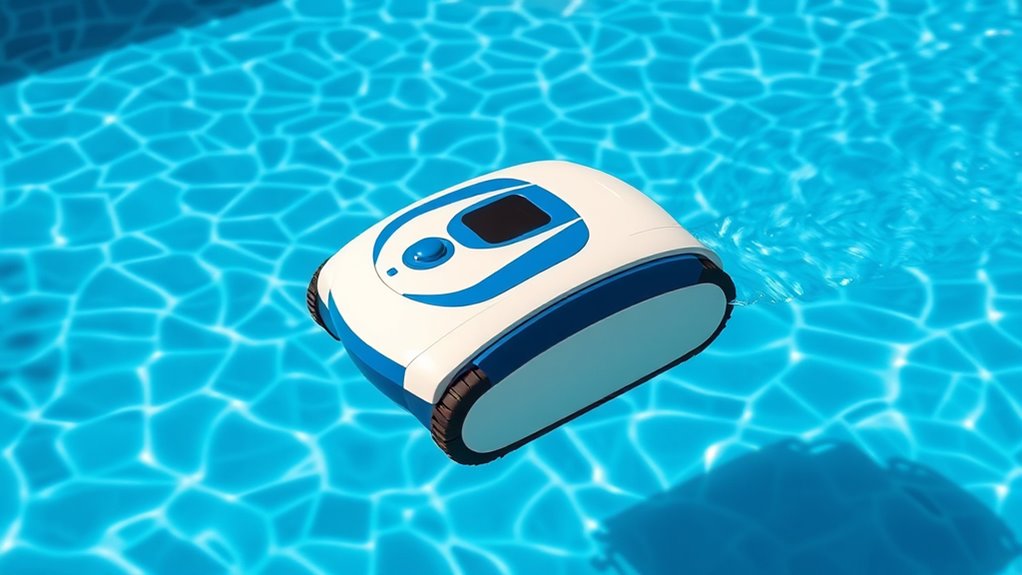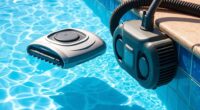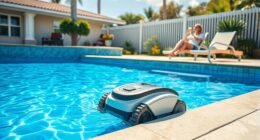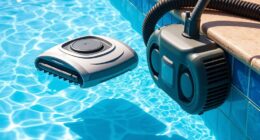Robotic pool cleaners use sensors, motors, and advanced algorithms to navigate your pool and detect debris automatically. They move across floors and walls using customizable cleaning modes, adjusting their path based on obstacles and water conditions. Powered by rechargeable batteries like lithium-ion, they filter out dirt and leaves with built-in water circulation systems. Proper maintenance guarantees peak performance. Want to know how all these features work together? Keep exploring to learn more.
Key Takeaways
- Robotic pool cleaners use onboard motors, brushes, and advanced sensors to navigate and scrub pool surfaces effectively.
- They employ algorithms and mapping techniques to follow walls, bounce patterns, or customize cleaning paths.
- Sensors detect obstacles, debris, and water chemistry changes, guiding adjustments for thorough cleaning coverage.
- They operate on rechargeable batteries, typically lithium-ion, which power movement, navigation, and filtration systems.
- Filters and debris collection units trap dirt and leaves, with regular maintenance ensuring optimal performance and longevity.
The Core Components of Robotic Pool Cleaners

Robotic pool cleaners rely on several key components working together to effectively clean your pool. A critical part is the onboard electronics that manage functions, including monitoring pool water chemistry to optimize cleaning cycles. These systems guarantee the cleaner adapts to different conditions, such as pH levels or chemical balance, maintaining efficiency. The user interface design also plays an essential role, making it easy for you to set up, schedule, and monitor the cleaner’s progress. Simple controls and clear displays help you operate the device without hassle. Additionally, internal motors and brushes work in harmony to scrub surfaces and navigate the pool. Together, these core components form a reliable system that keeps your pool clean while being user-friendly and responsive to your pool’s specific needs. The integration of automation in business technologies enhances the reliability and adaptability of robotic pool cleaners, allowing them to perform more efficiently under various conditions. Moreover, the use of advanced sensors allows these devices to detect obstacles and adjust their cleaning paths for better coverage and efficiency. Incorporating smart technology further improves their ability to adapt to different pool environments and user preferences. For example, sensor integration enables real-time adjustments, ensuring thorough cleaning without user intervention. Additionally, energy efficiency features help reduce power consumption while maintaining optimal cleaning performance.
How Sensors Guide the Cleaning Process

Sensors play a crucial role in guiding the cleaning process by providing real-time data that helps the robot adapt to its environment. Proper sensor calibration ensures accurate readings, so the cleaner can detect dirt, debris, and surface types effectively. When sensors are well-calibrated, the robot can identify areas needing more attention and avoid false signals. Obstacle detection is another vital function; sensors quickly identify objects or walls in the pool, preventing collisions and ensuring thorough coverage. As the cleaner moves, these sensors constantly relay information to its control system, allowing it to adjust its path and cleaning intensity. Regular maintenance of sensors is essential to maintain accuracy and performance, and many models include filter replacement reminders to help with upkeep. This seamless feedback loop makes the robotic pool cleaner efficient, safe, and capable of adapting to different pool shapes and sizes. Additionally, advancements in sensor technology enable even more precise navigation and obstacle avoidance, enhancing overall cleaning efficiency. For optimal operation, it’s also important to regularly calibrate sensors to maintain their accuracy and responsiveness. Proper sensor calibration, combined with advanced navigation, allows the cleaner to optimize coverage and reduce cleaning time.
Navigation and Movement Mechanisms
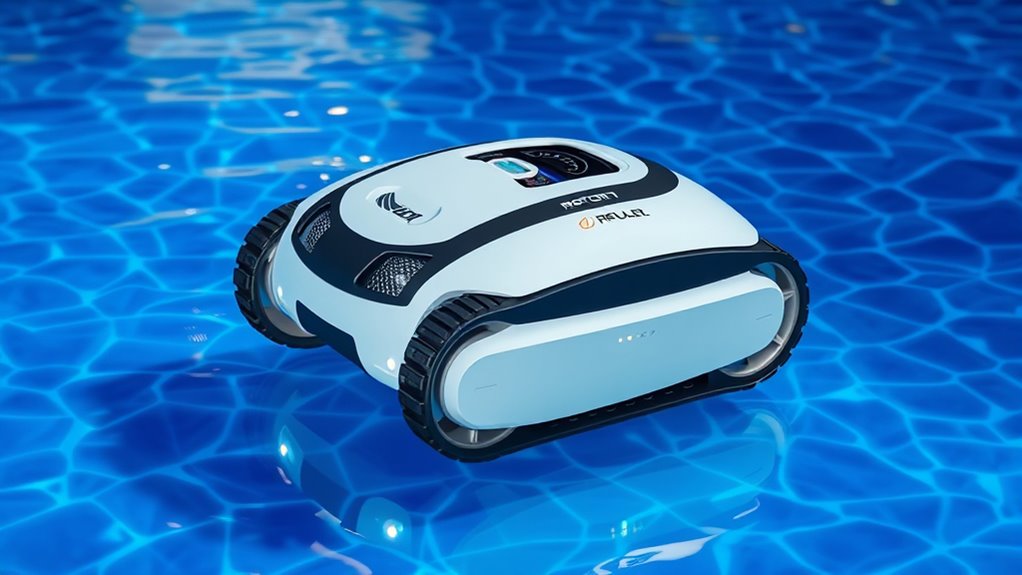
Navigation and movement mechanisms enable robotic pool cleaners to efficiently cover the entire surface area of your pool. They use advanced algorithms and sensors to map the pool surface, ensuring no spot is missed. These mechanisms help the cleaner navigate around obstacles and adapt to different pool shapes, whether rectangular or freeform. As water chemistry changes, such as pH levels or chlorination, some models adjust their movement to optimize cleaning performance. The robot’s movement patterns—like wall-following or random bouncing—maximize coverage and prevent missed areas. This intelligent navigation reduces cleaning time and improves efficiency, making sure your pool surface stays spotless. With these systems, you can trust your robotic cleaner to handle the complexities of your pool’s shape and water chemistry seamlessly.
Cleaning Modes and Programming Features
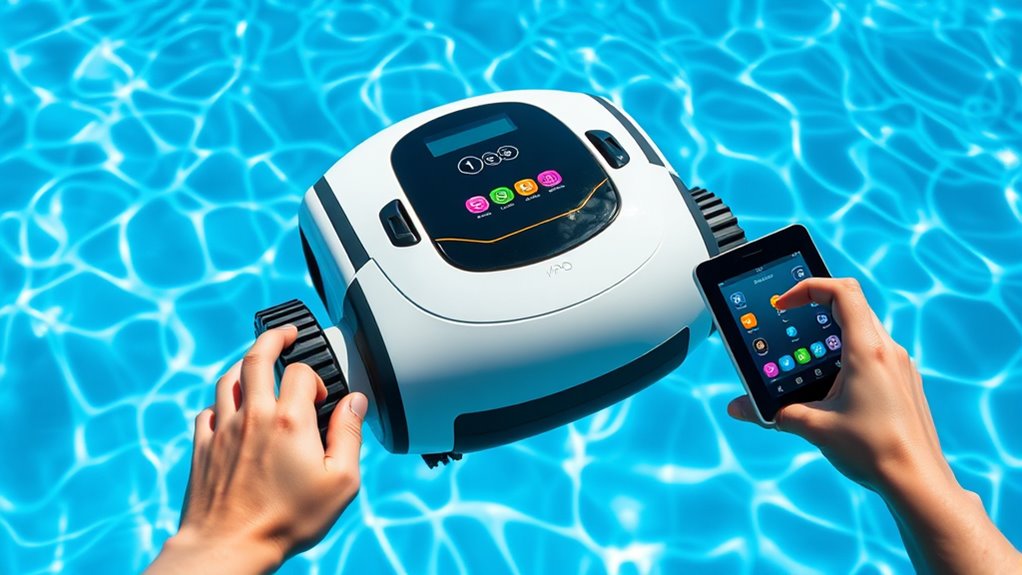
Robotic pool cleaners often come with multiple cleaning modes, allowing you to customize their performance for different needs. Smart programming features enable you to set schedules and control your cleaner remotely, making pool maintenance more convenient. Understanding these options helps you choose a model that fits your pool’s specific requirements. Additionally, some models incorporate performance upgrades such as enhanced navigation and power efficiency to improve cleaning effectiveness. Exploring these advanced features can help you select a device that best suits your pool environment, especially when considering technology integration for seamless operation. Moreover, incorporating standard operating procedures in maintenance can ensure the longevity and optimal performance of the cleaner.
Multiple Cleaning Modes
Many robotic pool cleaners offer multiple cleaning modes and programming features that let you customize their operation to suit your pool’s specific needs. You can choose modes like surface cleaning, deep cleaning, or spot cleaning, depending on water chemistry and debris buildup. These modes ensure the cleaner targets problem areas, enhancing pool safety and maintaining water quality. Imagine selecting a mode that focuses on the pool floor while avoiding walls or stairs. Here’s a quick overview:
| Mode | Purpose | Ideal For |
|---|---|---|
| Surface Clean | Skims water surface | Light debris, leaves |
| Deep Clean | Scrubs walls and floor | Dirt buildup, algae |
| Spot Cleaning | Focused, quick clean | Localized mess, water chemistry issues |
This flexibility helps keep your pool safe, clean, and balanced. Additionally, programmable features allow you to set cleaning schedules to automate maintenance routines. Incorporating automation technology can further optimize cleaning efficiency and reduce manual oversight. Using appropriate filter types ensures optimal debris removal and prolongs the lifespan of your robotic cleaner. Moreover, understanding the importance of regular maintenance can significantly improve the performance and longevity of your device. Utilizing natural techniques in pool maintenance can also contribute to healthier water quality and reduce chemical use.
Smart Programming Features
Smart programming features give you greater control over your pool cleaner’s performance by allowing you to customize cleaning modes and set schedules that fit your pool’s specific needs. With these features, you can select different cleaning modes based on your pool’s size, shape, and debris level, ensuring thorough coverage. Setting schedules helps maintain a consistent cleaning routine, even when you’re not home. Properly programmed cleaners also support maintaining the pool’s chemical balance by reducing debris buildup, which can affect water chemistry. Additionally, adhering to pool safety protocols becomes easier, as you can program the cleaner to operate during off-peak hours. These features optimize cleaning efficiency, promote a safe swimming environment, and help keep your pool in top condition with minimal effort. Incorporating regular maintenance routines ensures the longevity and optimal performance of your robotic pool cleaner. Furthermore, smart features allow you to monitor and adjust cleaning performance remotely, providing added convenience and peace of mind.
Power Supply and Battery Technology
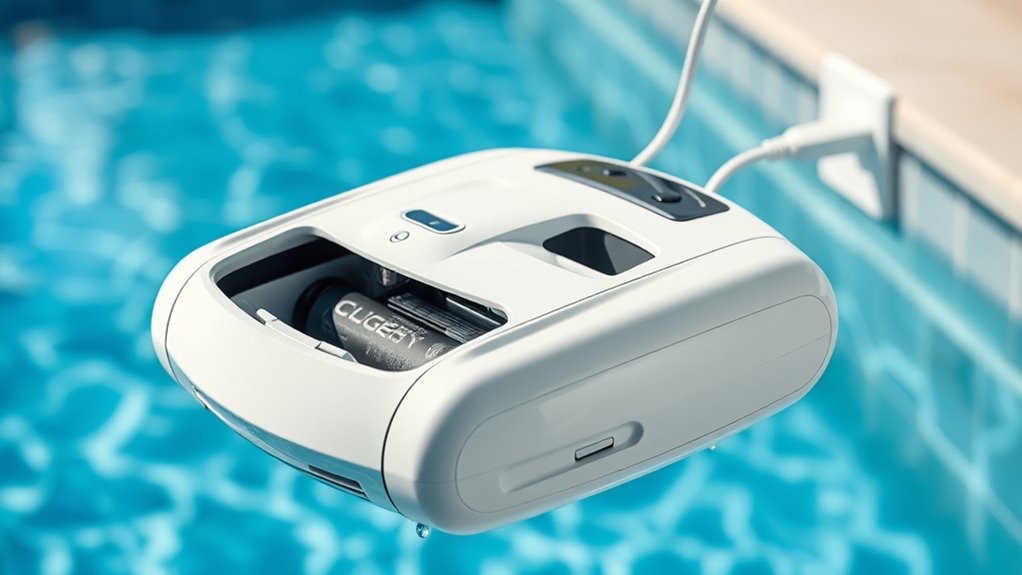
Power supply and battery technology are crucial for ensuring your robotic pool cleaner operates efficiently and reliably. High-quality batteries provide better power efficiency and extend the battery lifespan, so your cleaner works longer between charges. Most models use rechargeable lithium-ion batteries, which balance weight and durability. To visualize this, consider the following:
| Battery Type | Power Efficiency | Battery Lifespan |
|---|---|---|
| Lithium-ion | High | 2-3 years |
| Nickel-metal hydride | Moderate | 1-2 years |
| Lead-acid | Low | Less than 1 year |
Choosing the right power source ensures your cleaner runs seamlessly, saving you time and effort while keeping your pool spotless.
Water Filtration and Debris Collection
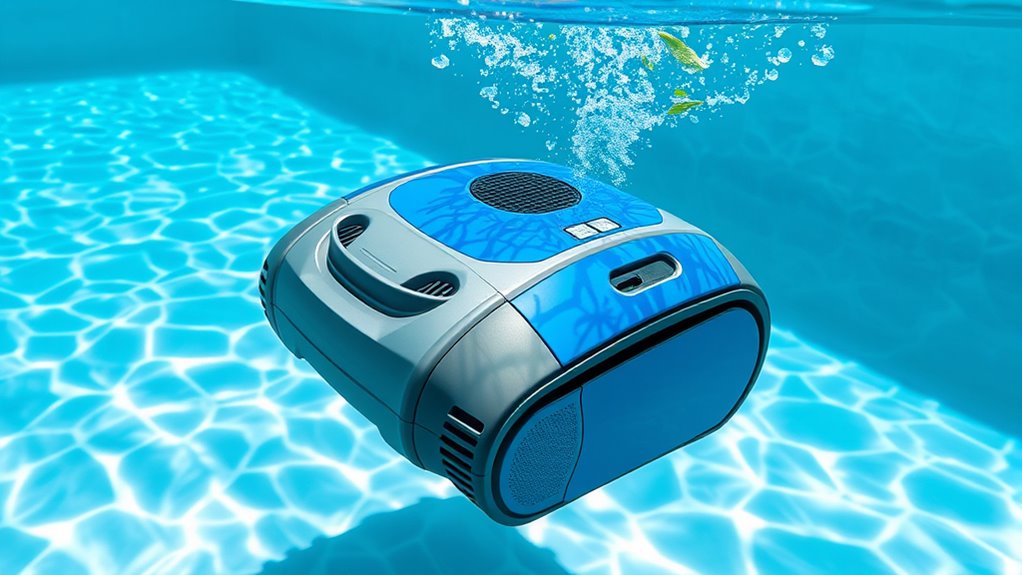
Effective water filtration and debris collection are essential for maintaining a clean and healthy pool. Your robotic cleaner uses advanced water circulation to efficiently gather dirt, leaves, and debris from all pool areas. As it moves, it pulls water through its filtration system, trapping particles in its filters or cartridges. This process helps prevent clogs and keeps the water clear. Proper filtration also supports chemical balancing by removing organic matter that could affect pH levels and sanitizer effectiveness. Regularly cleaning or replacing filters guarantees ideal performance. By continuously filtering water, your robotic cleaner minimizes the need for chemical adjustments and manual cleaning, making pool maintenance easier and more effective. This combination of filtration and debris collection keeps your pool fresh, clean, and safe for swimming.
Maintenance and Troubleshooting Tips
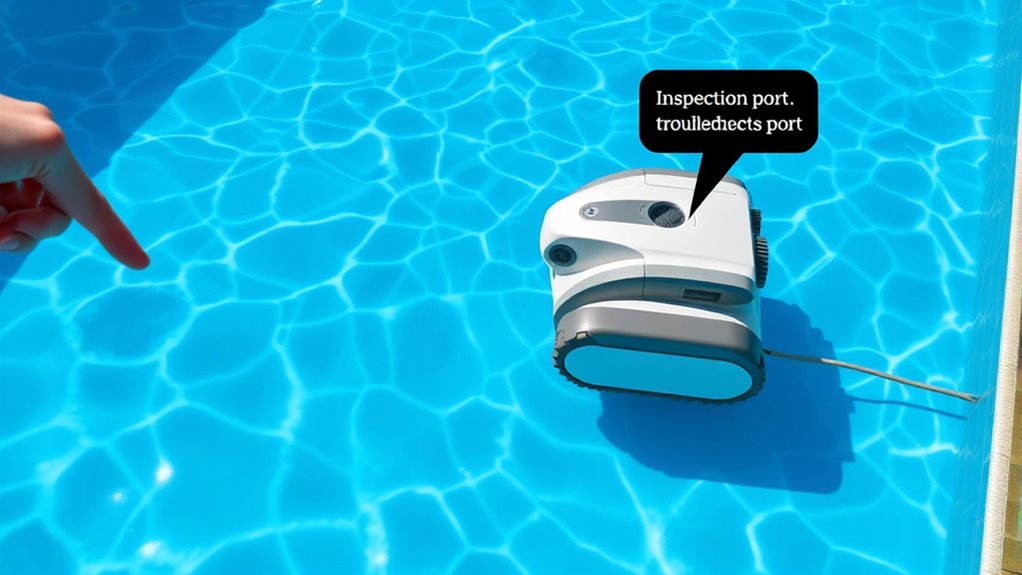
To keep your robotic pool cleaner running smoothly, you need to perform regular maintenance checks and clean the filter components. If it’s not working properly, troubleshooting common issues can save you time and frustration. Staying proactive helps prolong the life of your cleaner and ensures your pool stays spotless.
Regular Maintenance Checks
Regular maintenance checks are essential to keep your robotic pool cleaner functioning smoothly and prevent costly repairs. Regularly inspect the filter for debris and perform filter replacement when needed to maintain peak suction. Also, monitor the battery lifespan; charging it correctly and avoiding overuse helps extend its life. To keep your cleaner in top shape, consider these steps:
- Check the filter for clogs or dirt and replace it as recommended.
- Keep the battery charged but avoid overcharging to prolong its lifespan.
- Inspect brushes and wheels for wear and replace if necessary.
These simple checks help ensure your cleaner operates efficiently, saving you time and money in the long run. Consistent maintenance keeps your pool sparkling clean and extends the device’s longevity.
Cleaning Filter Components
Since clogged or dirty filter components can reduce your robotic pool cleaner’s performance, it’s important to clean them regularly. Start by removing the debris bag and emptying it completely, then rinse it with water to remove any remaining dirt. Check the filter for blockages or debris buildup and clean or replace it if necessary. Regular debris bag cleaning guarantees peak suction and cleaning efficiency. Over time, filters may wear out or become less effective, so consider getting a filter replacement when cleaning no longer restores performance. Keeping your filter components clean prevents clogs and extends the lifespan of your cleaner. Make this a routine part of your maintenance to keep your robotic pool cleaner running smoothly and effectively.
Troubleshooting Common Issues
Even the best robotic pool cleaners can encounter issues from time to time, but many problems are simple to troubleshoot. First, if your cleaner isn’t moving properly, check its outdoor placement—shaded areas can affect performance. Second, if it’s not cleaning effectively, verify the pool chemicals; imbalanced chemicals can cause debris buildup. Third, if the brushes or wheels are stuck, inspect for tangled debris or obstructions. Regularly clean the filter components and ensure the robot’s sensors aren’t covered in dirt or algae. Proper placement and maintenance help prevent common issues. If problems persist, resetting the device or replacing worn parts can often get your cleaner back in working order quickly. Staying attentive to these tips saves time and keeps your pool spotless.
Frequently Asked Questions
How Long Can a Robotic Pool Cleaner Operate on a Single Charge?
You might wonder how long a robotic pool cleaner can run on a single charge. Typically, their battery life lasts between 1.5 to 2 hours, depending on the model and the complexity of cleaning. After that, you’ll need to place it on its charging cycle, which usually takes about 3 to 4 hours. Be sure to check your device’s specifications for the exact battery life and charging cycle times.
Are Robotic Pool Cleaners Suitable for All Pool Types and Shapes?
Imagine fitting a key into a lock—some keys work perfectly, others don’t fit. Similarly, robotic pool cleaners suit most pool sizes and shapes, but not all. If you have a small, rectangular pool, most cleaners will do the trick. However, for complex shapes or large pools, you might need a more specialized model. Always check the product’s shape compatibility and pool size limits before buying.
How Often Should I Replace the Filters or Brushes?
You should replace filters and perform brush replacement based on your robotic pool cleaner’s usage and the manufacturer’s recommendations. Generally, do filter maintenance every 1-2 months to keep performance ideal, and replace brushes every 6-12 months or when they show significant wear. Regularly checking these parts ensures your cleaner runs efficiently, extends its lifespan, and keeps your pool spotless.
Can Robotic Pool Cleaners Handle Algae or Tough Stains?
Robotic pool cleaners can handle algae removal and stain treatment, but their effectiveness depends on the model. They excel at scrubbing and vacuuming debris, including some algae buildup. For tough stains, you might need to pre-treat the area or use specialized chemicals. Regular maintenance helps keep your cleaner working efficiently. While robotic cleaners are great for routine cleaning, severe algae or stains may require manual scrubbing or chemical treatments for best results.
What Safety Precautions Should I Observe When Using a Robotic Pool Cleaner?
Oh, safety’s overrated, right? Just kidding! When using a robotic pool cleaner, you should always prioritize electric cord safety by keeping cords away from water and sharp objects. Make sure to place the cleaner properly, avoiding tangled cords or obstructed pathways. Check for secure connections and follow the manufacturer’s instructions. After all, a little caution keeps your pool clean and your day accident-free!
Conclusion
Now that you know how robotic pool cleaners work, you’re armed with the knowledge to keep your pool sparkling with less effort. These little machines are truly the heartbeat of effortless cleaning, making the chore feel like a walk in the park. Remember, a well-maintained robot is the key to a pristine pool—don’t let it slip through your fingers. With proper care, your cleaner will be your loyal ally for years to come.
